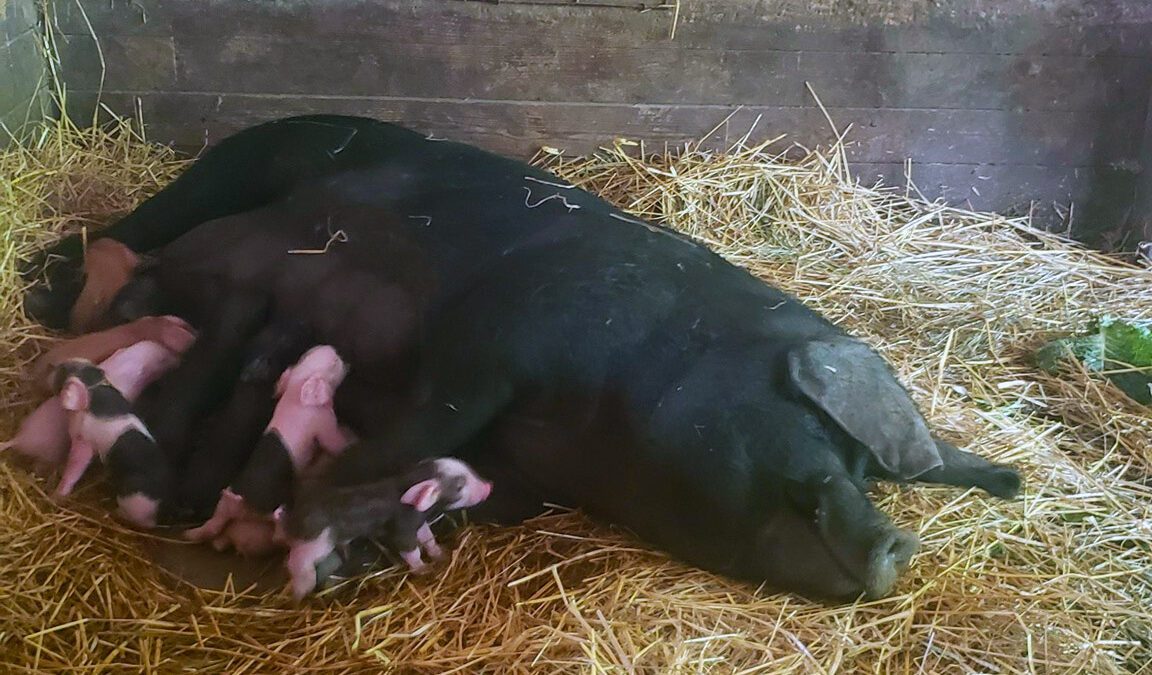
Discover the Source of a Spring Tonic
April 2, 2011
Beware of the Bull
July 2, 2011Published in The Delaware Gazette: May 7, 2011
This month marks the beginning of the fourth year, for publication of the “Farm Connection” article, in the Delaware Gazette on the first Saturday of the month. It is a pleasure to connect readers with life on the farm at Stratford Ecological Center on Liberty Road. It has also been heartening to hear your positive reaction and we continue to welcome input about the content. As more and more of us lead lives off the farm, we believe the article plays an important role in reminding us of the source of our food, and to think about how our daily actions may affect the environment and our food and water quality. We are grateful for the co‐operation of the Delaware Gazette.
After experiencing probably the wettest April on record, it is interesting to look back to the month of April in the last three years. In 2008, I shared that everyone appreciated the recent dry weather, which allowed us to cultivate the vegetable field and, by late April, start preparations for planting in the other fields. April 2009 was the driest spring Farmer, Jeff Dickinson could remember, and he had everything planted by the end of April. In 2010 there were only a few scattered April showers and a few hard frosts but mostly it was exceptionally warm, resulting in the fruit trees and perennials being weeks ahead and an early hay harvest anticipated.
It is understandable Farmer Jeff is getting anxious about how soon the land will dry out enough to work and plant. The cool weather vegetable plants like cabbage, broccoli, lettuce, and spinach, are sitting in trays on a wire table outside the greenhouse. As it does these crops good to “harden off” for a longish period before planting, they should do ok when we get them in, but will require extra watering and definitely a mulch of old hay.
The new June‐bearing strawberries were planted in four raised beds in the Children’s Garden, but even they got off too late to establish themselves fully and will need babying in the heat of summer. There has been enough heat in the greenhouse to cause many of the greens to bolt. Some will be pulled out specifically for the hens, others for the goats and pigs. Warm season crops of tomatoes and peppers will take their place.
Our most pressing need is to sow oats for oat hay, where last year’s corn stalks remain in field 6. We have until June 15 to plant corn and early August to plant buckwheat.
Four out of the five Shetland ewes have lambs of various colors. The Shetland and nine Tunis ewes have produced twenty nine lambs. This equates to a great lambing average.
Amelia was our first nanny goat to kid on April 5 with twin boys. One has a very distinct black line along his back. Amelia must be deficient in selenium as both kids exhibited signs in their first ten days. Farmer Jeff treated them by injection and, despite his doubts, they are now totally healthy. Liberty, usually first to kid, was the last. There were 2 sets of triplets. The herd now includes ten nannies and seventeen kids.
First grader Andres, son of April Hoy, Stratford’s Field Trip Coordinator, was a great help moving the hens from the Children’s Garden into the orchard on April 26. He was assisted by freshmen students from Thomas Worthington High School, who were attending a class on farming scale, diversity of production and rotation. One girl was adamant about not touching any animals, but the lambs seduced her and she held one, and went on to carry three hens.
Andres was not so helpful in the eyes of a group of girls, when he inadvertently allowed the rooster to escape. The girls shrieked at the sight of the large glossy‐feathered bird walking majestically towards them. Andres, like a prince, went to save them, only to find the rooster had dug its hind claws into the ground and he could not lift it. Mom came to his rescue and after some effort on her part, the rooster joined the hens.
A long awaited Tamworth pig arrived on April 28 from Darke County, delivered by her breeder, Paul Morrison, a big supporter of 4‐H. She was artificially inseminated in early February and is due the first week of June. She came with registration papers validating her pedigree.
Our new arrival is quite a beauty, although her ears take a little getting used to. They have been gently lobed like an oak leaf, as a means of identifying her, and resemble a bird in flight or the ears of a moose! We have the option of registering her off spring and breeding them in November, to produce piglets for 4‐H projects in the spring. Along with her came two eight‐week old Tamworth babes to be fattened for sale.
Please join us for monthly Story Time for young families on Tuesday, May 10 from 10‐11 am. It costs $5/family with no pre‐registration. The Herbal Study Group meets on the same day from 1‐3 pm., and a new group meets on Saturday, May 28 from 9‐11 am. Members share their knowledge and new people are welcome to join them. There are still openings in our first ever outside Yoga classes. The class is offered each Friday evening at 6.00 pm., through May, at a cost of $12.00 per class. Please call to register.
“Farm Connection” is a monthly article connecting city folk to life on the Stratford Ecological Center farm. It is published on the first Saturday of the month on the farm and garden page of The Delaware Gazette.





